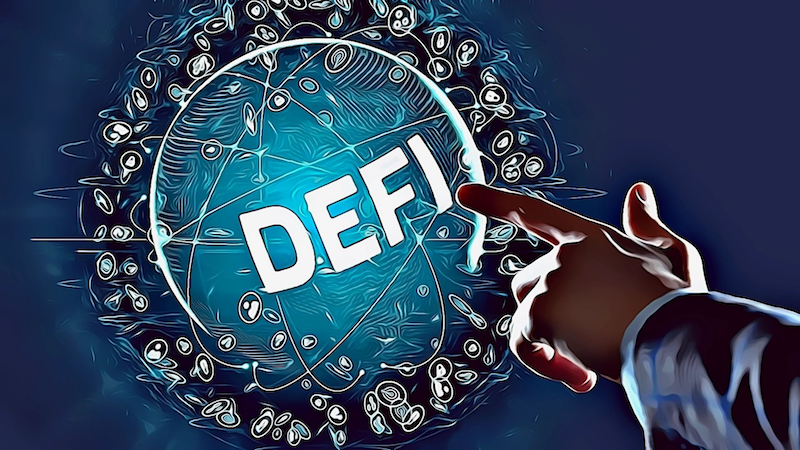Join Our Telegram channel to stay up to date on breaking news coverage
The decentralized finance (DeFi) industry has been experiencing a severe bear market for some time, and as a result, the total value of assets that are currently locked up in this market has dropped from its all-time high of $150 billion (attained back in May 2022) to just over $50 billion.
Despite this, there has been an increase in the amount of money coming from “centralized routes” into this sector, partly as a result of the demise of FTX and other well-known companies like Celsius, Genesis, Vauld, etc. Trading volumes on various platforms have even doubled just in November 2022. However, despite the recent market volatility, a number of decentralized exchanges and lending platforms kept running without any major issues, especially when compared to their centralized equivalents.
DeFi must undergo a dramatic shift for the industry to properly realize its full potential. This is because there are a lot of protocols working in this area that have been giving people unsustainable returns for a very long time. However, interest among investors in decentralized options appears to be waning in light of the recent increase in interest rates, inflation levels, and the so-called “risk-free” rate of return on six-month Treasury notes topping 5%.
In reality, even the fast shifting macroeconomic climate has had an impact on DeFi, leading to considerable adjustments in incentive structures from a number of well-established projects merely to stay competitive. For instance, MakerDAO just approved a vote to tenfold its DAI savings rate to 1%.
How can DeFi win back customers’ trust?
The decentralized infrastructure platform AllianceBlock, which connects conventional financial institutions to Web3 apps, was founded and is led by Rachid Ajaja. According to Ajaja, the current stage of the DeFi market is similar to that of all other worldwide markets: a cycle. Investor trust was undoubtedly shaken by what happened with Terra, Celsius, Three Arrows Capital, and FTX, but the issue is with the market’s participants, not the technology, rather it is with the players themselves. In a conversation with Cointelegraph, he stated that:
DeFi must concentrate on solutions that prioritize and safeguard consumers in order to increase and preserve customer confidence. Working toward compliant DeFi systems that emphasize identity management, data encryption, user data ownership, and trustless KYC processes is necessary to achieve this.
This “may open the door for the tokenization of physical assets and financial instruments, therefore luring greater cash flow into DeFi, even from established actors and institutions who place a high priority on compliance and sustainability,” he continued.
Varun Kumar, the creator and CEO of the decentralized exchange Hashflow, concurred with this statement, saying that the current state of this niche market calls for better solutions that are able to address real-world issues. The DeFi ecosystem, according to him, is still in the research phase as many initiatives are still determining how well they fit into their individual markets.
Despite the fact that there is a clear link between falling dollar volumes and consumer confidence, Kumar argued that it’s vital to take other aspects into account as well. For instance, a robust macroeconomic climate contributed to the DeFi boom of 2021, which had a big influence on the industry:
This rapid expansion provided the industry with a wonderful springboard and many opportunities. Business models and value propositions are changing, nonetheless, as a result of the altered circumstances and significantly reduced volumes. Better goods will always prevail, and as a result, customer confidence will follow.
According to Juana Attieh, co-founder and chief product officer of Fluus, an organization that gathers fiat-to-crypto gateways with a crypto ramping network, DeFi’s decline and loss of trust have been caused by centralized entities repeatedly abusing their power and taking advantage of their customers.
She thinks DeFi players should put an emphasis on increasing openness and developing standards for exchanging details regarding underlying assets, protocols, governance structures, and other topics in order to restore market trust.
To safeguard user assets and information, security procedures must be greatly upgraded. This might entail carrying out routine audits, putting in place bug bounties, and other precautions to guarantee the security and safety of DeFi protocols,” she stated.
Attieh also thinks that tight collaboration between the industry and lawmakers is essential if the sector is to achieve regulatory clarity and create governance frameworks that will lessen volatility and uncertainty while regaining confidence.
It’s not all horrible, though
Robert Miller, vice president of growth for Fuse, a blockchain-based Web3 payments ecosystem, said in an interview with Cointelegraph that despite the market’s current lull, DeFi (specifically automated market maker-based applications) appears to have found an incredibly successful product-market fit during the previous innovation cycle. He said,
Notwithstanding the decline, the fact that $50 billion in liquidity is still being used for DeFi protocols is exciting and unheard of in the financial industry, where we usually need to rely on institutional market makers and lenders as the spark to get the economy rolling again.
Miller acknowledged that more customer demand and confidence can only result from better user experiences. He said, “I can’t image how tough it must be for the layperson because even as an experienced crypto specialist, I still have trouble utilizing popular DeFi programs.
In order for anything to finally stabilize, according to Andy Ku, CEO of Altava Group, a digital content Web3 ecosystem, sometimes it has to go pretty awful. According to him, dishonest people have in the past loosely referred to systems like DeFi to advertise ones that were close to becoming totally centralized.
Nevertheless, in his opinion, the majority of high-quality DeFi projects currently in existence are firmly rooted in the transparency ethos, with an expanding number of these offerings currently undergoing smart contract audits and publishing proof-of-reserve reports to help reestablish confidence in this market. He added that:
DeFi was founded as a result of the rising disdain for conventional banking institutions. The current balancing act is figuring out how to transform DeFi into something that has greater openness, oversight, and responsibility.
What direction is DeFi going in?
Ajaja thinks that after taking lessons from the several high-profile scandals of 2022, the next wave of DeFi will have a larger emphasis on compliance and consumer experience. In this regard, she pointed out that initiatives aimed at delivering compliant DeFi solutions that incorporate trustless Know Your Customer and Know Your Transaction protocols are already on the increase. These protocols are essential for long-term adoption by conventional businesses.
In addition, the idea of self-custody is quickly gaining importance in users’ thoughts as more and more DeFi projects develop self-custodial wallet solutions that allow users complete control and ownership of their assets and data. Digital wallets provide users complete control over how they share this information and make it simple to maintain and recover assets, save encrypted digital identities, and store verified credentials.
Attieh thinks that even though the bear market may have led to a decline in the use of some DeFi projects, especially as investors become more risk-averse, it is likely that the most solid projects with solid fundamentals and practical use cases will continue to flourish and gain traction, even in difficult economic circumstances.
Similar to this, Daniel Fogg, president and chief operating officer of IOVLabs, the company that created Rootstock, a smart contract platform protected by the Bitcoin Network, said that the only good thing to come out of the current crypto winter is that it has lessened the white noise surrounding the ecosystem. He continued,
There are more construction companies and fewer buzzwords. Teams developing crypto initiatives need to put a strong emphasis on accessibility, usability, and utility if they want to help the DeFi sector overcome the chasm. We need to create products that assist actual people in solving their difficulties, such as paying their bills, sending money to family members abroad, avoiding inflationary overheating, and locating secure financial institutions.
Therefore, as we move toward a future dominated by decentralized technology, it will be interesting to observe how the quickly developing decentralized financial paradigm continues to develop, especially as more and more individuals start to seek out alternatives to using intermediaries.
Related
Join Our Telegram channel to stay up to date on breaking news coverage


